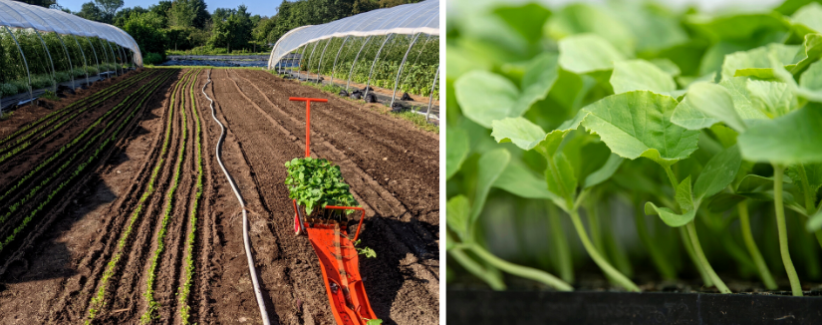Connecting the Past and Future of Food Through Seed Saving

In mid-November, Farmer Erin Espinosa visited the Children’s Meetinghouse preschool in Concord to teach the students there about seed saving—the practice of collecting seeds from open-pollinated food crops and using them to grow future harvests of those plants. Her visit was a reminder of the importance of learning about the life cycles of plants, food growing, and food sovereignty.
Summer and fall are the seasons when many growers can be found collecting vegetable, fruit, herb, and flower seeds from their fields for the next year. Winter—where we find ourselves today—isn’t the time to do seed saving, but it is the perfect moment to learn more about the process and plan for next season’s crop.
As the folks from Soul Fire Farm—an Afro-Indigenous-centered community farm committed to uprooting racism and promoting sovereignty in the food system—put it: “Seeds are a part of our history and a nod to the potential of our futures, they contain our familial legacy, the genetic heritage of the crop, and they are insurance for the future.”
Seed saving is an essential and meaningful practice, yet it isn’t possible or practical for everyone, which is why most farms buy their seeds. Since the development of specialized, highly-productive hybrid crop varieties in the 1930s, large-scale seed saving by farms in the U.S. has widely gone out of practice. But saving and sharing seed is still a common practice among smaller growers and gardeners, and can be a powerful tool for improving food security and access.

At Gaining Ground we don’t practice seed saving for most of our crops, a decision that largely boils down to logistics and our core focus on growing food for hunger relief. To get the best results, farmers set aside growing space for breeding seed rather than harvesting food. They then grow enough plants to be able to experiment and choose those with the characteristics they want to preserve. The decision to buy or save seeds can also be one of efficiency and expertise. By buying seed, food growers can instead dedicate themselves, their equipment, and the space on their farms to raising the best produce possible.
For us, large-scale seed saving would mean growing less food for people experiencing food insecurity—but there are certainly crops for which we can and do save seeds!
Every year, we set aside a portion of our garlic harvest to seed next year’s batch. Each clove planted back into the earth then forms a new head and can be used to begin the cycle anew. According to farming folklore, if you save seed for seven years—planting and re-harvesting it each season—the variety you are using becomes your own. And if you believe this, then Gaining Ground possesses its own variety of garlic since the farm hasn’t bought seed in nearly a decade. For the past two years, we have also harvested our dahlia tubers at the end of the growing season. These tubers are not winter hardy in our area and can freeze and split or rot in the ground if left to overwinter. At the end of the season, we dig them up, clean and dry them, store them in the barn for the winter, and then replant them in spring to seed the coming year’s blooms.

Despite the challenges, there are many excellent reasons to learn about saving seed:
- The practice can be an important aspect of food sovereignty. As food prices rise and economic strain endures, saving and sharing seeds can make practical economic sense. With a little know-how, seed saving can cost very little for small-scale practitioners. There are seed libraries, exchanges, and other community groups that offer seeds for free or very low prices. In this way, folks who practice seed saving can control the cost of their food as well as the cost of their future seeds.
- Seed saving helps communities protect and preserve food culture. Heirloom crops exist because of the growers—spanning generations and continents—who devotedly grew, saved, and shared seeds. Every seed has a history, which is inseparable from the story of the people who cultivated it. Some groups practice seed saving as a way to preserve Black and Indigenous culture and historically important crops for future generations.
- The world’s growing conditions are diverse and—because of climate change—the future of food-growing is unpredictable. In a warming world, the practice of saving seeds from the healthiest plants year after year enables growers to develop varieties adapted to their particular climate and the specific challenges they encounter. Adaptation through seed saving can increase the resilience of our future food system and provide a safeguard against the effects of climate change.
- Saving and sharing seeds can also help reverse seed consolidation and protect biodiversity, which preserves the incredible range of flavor, beauty, and nutritional richness found in our heritage varieties. Today, commercial seed privatization and patenting has dramatically reduced the diversity of crops available through the pursuit of maximizing efficiency, plant productivity, and profit. Growers who persist in using open source, open-pollinated seeds safeguard the biodiversity of crops for future generations.

If you’re ready to get started saving seed, there are some fantastic resources available to explain the process and techniques. You can find helpful overviews online from UMN Extension and Seed Savers Exchange, as well as more in-depth instructions from Organic Seed Alliance. For additional reading, you can also check out Soul Fire Farm’s book, “Farming While Black,” Suzanne Ashworth’s “Seed to Seed,” or “Seed Sowing and Saving,” by Carole Turner.
There are also several seed lending libraries to explore in the area. Right here in Concord, you can find one at the Concord Free Public Library. In Boston, there is a seed library at the Egelston Square Branch of the Boston Public Library. And in Framingham, visitors can check out the seeds at the Framingham Public Library. You can learn more, pick up some seeds, and get started with your 2022 growing—and seed saving—plans.